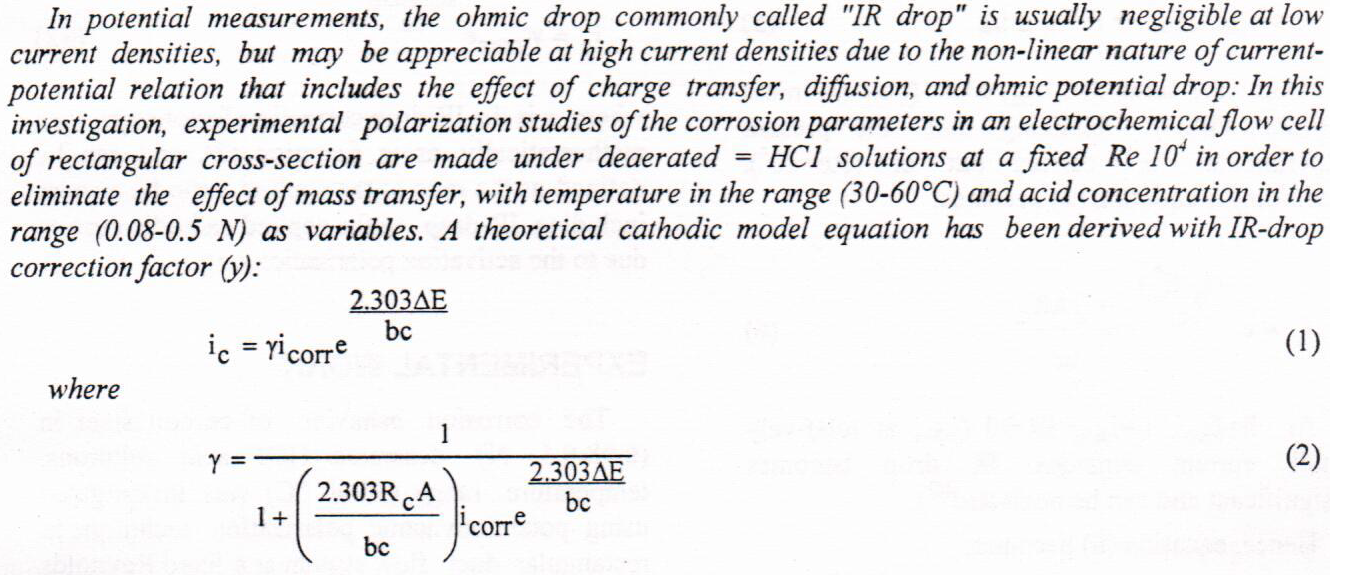
A simple and rapid spectrophotometric method for the determination of sulphite SO3-2 is described. The method is based on the rapid reduction of known amount of chromate CrO4-2 in the presence of sulphite in acidic medium of 2N H2SO4. The amount of excess of chromate was measured after it reactions with 1,5-diphenylcarbazide which finally gives a pink-violet, water soluble and stable complex, which exhibit a maximum absorption at 542 nm. Beer's law was obeyed in the concentration range from 0.004-6.0 µg of sulphite in a final volume of 25 ml with a molar absorbtivity of 4.64×104 l.mol-1.cm-1, Sandal's sensitivity index of 0.001724 ?g .cm-2 and relative standard deviation of ±0.55 - ±0.83 depending on the concentration level. The present
... Show More (5)
(5)
 (4)
(4)
The petroleum sector has a significant influence on the development of multiphase detection sensor techniques; to separate the crude oil from water, the crude oil tank is used. In this paper, a measuring system using a simple and low cost two parallel plate capacitance sensor is designed and implemented based on a Micro controlled embedded system plus PC to automatically identify the (gas/oil) and (oil/water) dynamic multi-interface in the crude oil tank. The Permittivity differences of two-phase liquids are used to determine the interface of them by measuring the relative changes of the sensor’s capacitance when passes through the liquid’s interface. The experiment results to determine the liquid’s interface is sa
... Show More (7)
(7)
 (7)
(7)
This approach was developed to achieve an accurate, fast, economic and sensitivity to estimation of diphenhydramine Hydrochloride. The dye that produced via reaction between diphenhydramine HCl with thymol blue in acidic medium pH ≈ 4.0. The ion pair method include an optimization study to formed yellowcolored that extraction by liquid – liquid method. The product separated of complexes by using by chloroform solution measured spectrophotometry at 400 nm. The analysis data at optimum conditions showed that linearity concentration in a range of calibration curve 1.0 – 50 μg /mL, limit of detectionand limit of quantification 0.0786 and 0.2358 μg/mL respectively. The molar absorptivity and Sandell’s sensitivity were 1.8 × 10 -4 L/mo
... Show MoreThe optical absorption data of Hydrogenated Amorphous Silicon was analyzed using a Dunstan model of optical absorption in amorphous semiconductors. This model introduces disorder into the band-band absorption through a linear exponential distribution of local energy gaps, and it accounts for both the Urbach and Tauc regions of the optical absorption edge.Compared to other models of similar bases, such as the O’Leary and Guerra models, it is simpler to understand mathematically and has a physical meaning. The optical absorption data of Jackson et al and Maurer et al were successfully interpreted using Dunstan’s model. Useful physical parameters are extracted especially the band to the band energy gap , which is the energy gap in the a
... Show MoreThe humid and warm conditions in greenhouses provide an excellent environment for pests’ living conditions, and therefore, they provide ideal medium for alien introductions. Molluscs are among the most significant pests that infest plastic covered greenhouses. To identify and report their mollusc species, 23 greenhouses in Iraq were surveyed between March 2023 and April 2024. Of these, 11 were found to be infested with snails. A total of 158 specimens were collected and morphologically identified to seven species: Monacha obstructa (L. Pfeiffer, 1842), Eobania vermiculata (O.F. Müller, 1774), Xeropicta krynickii (Krynicki, 1833), Rumina decollata (Linnaeus, 1758), Polygyra cereolus (Megerle Von Mühlfeld, 1818), Cochlicella barba
... Show More (20)
(20)
 (34)
(34)
An intrusion detection system (IDS) is key to having a comprehensive cybersecurity solution against any attack, and artificial intelligence techniques have been combined with all the features of the IoT to improve security. In response to this, in this research, an IDS technique driven by a modified random forest algorithm has been formulated to improve the system for IoT. To this end, the target is made as one-hot encoding, bootstrapping with less redundancy, adding a hybrid features selection method into the random forest algorithm, and modifying the ranking stage in the random forest algorithm. Furthermore, three datasets have been used in this research, IoTID20, UNSW-NB15, and IoT-23. The results are compared with the three datasets men
... Show More (5)
(5)
 (3)
(3)
This paper proposes a collaborative system called Recycle Rewarding System (RRS), and focuses on the aspect of using information communication technology (ICT) as a tool to promote greening. The idea behind RRS is to encourage recycling collectors by paying them for earning points. In doing so, both the industries and individuals reap the economical benefits of such system. Finally, and more importantly, the system intends to achieve a green environment for the Earth. This paper discusses the design and implementation of the RRS, involves: the architectural design, selection of components, and implementation issues. Five modules are used to construct the system, namely: database, data entry, points collecting and recording, points reward
... Show More (2)
(2)
